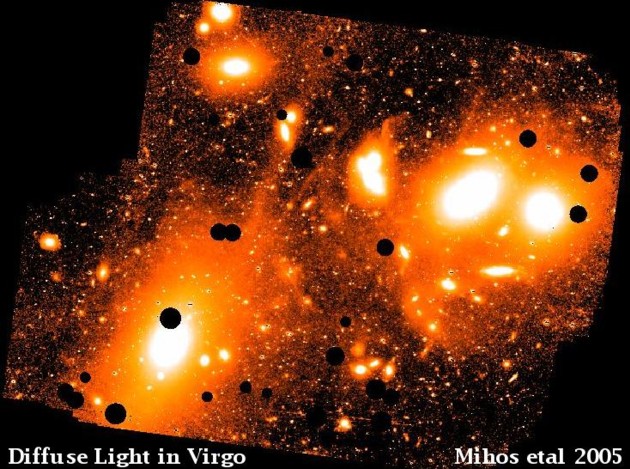
home •
about •
essential guide •
picture of the day •
thunderblogs •
news •
multimedia •
predictions •
products •
get involved •
contact
picture of the day archive subject index
May 23, 2006
The Virgo Cluster CircuitA new technique that reveals faint structures among the galaxies of the Virgo Cluster confirms the predicted existence of intergalactic plasma circuits.
This image of faint luminosity among the galaxies of the Virgo Cluster was recently published with this caption:
“Case Western Reserve University astronomers have captured the deepest wide-field image ever of the nearby Virgo cluster of galaxies, directly revealing for the first time a vast, complex web of ‘intracluster starlight’—nearly 1,000 times fainter than the dark night sky—filling the space between the galaxies within the cluster. The streamers, plumes and cocoons that make up this extremely faint starlight are made of stars ripped out of galaxies as they collide with one another inside the cluster, and act as a sort of ‘archaeological record’ of the violent lives of cluster galaxies.”
Plasma astronomers immediately recognize the “streamers, plumes and cocoons” as Birkeland currents and plasma sheaths. This image is direct confirmation of the intergalactic circuits connecting galaxies that plasma cosmologists predicted.
In an Electric Universe, these luminous plasma features are not “ripped out of galaxies as they collide” but are assembled from the sparse particles that make up the intergalactic plasma. The electromagnetic forces of a Birkeland current diminish directly with distance from the current (rather than with the square of the distance from a body as gravity does). Therefore, these forces have a much stronger and longer-reaching effect: They act as “cosmic vacuum cleaners”, pulling in and concentrating matter from great distances.
This “pinch effect” organizes the plasma into filaments that act as “power cables”. Because these cables attract each other when far apart but repel each other when close, they tend to spiral around each other. At points of sufficiently strong interaction, the matter in the cables will be stretched into arcs, and a “sump” or bulge will accumulate between them. This generates the familiar form of a spiral galaxy. Hence, galaxies are “loads” on the intergalactic circuits, similar to streetlights on a municipal power grid.
Variations in such factors as density, temperature, or composition along the cables trigger the formation of double layers and sheaths. These formations separate the plasma into bubbles or cells that tend to have the same properties. The cells organize further, in a fractal-like manner, with smaller filaments and cells inside them. In nearby galaxies, we see this subdivision as nebulas and stars. The intergalactic currents should also appear “knotted” into bright spots and clusters of stars.
________________________________________________________________________________________________Please visit our Forum
The Electric Sky and The Electric Universe available now!

|
|

|
EXECUTIVE EDITORS:
David Talbott, Wallace Thornhill
MANAGING EDITOR:
Michael Armstrong
CONTRIBUTING EDITORS: Dwardu Cardona, Ev Cochrane,
C.J. Ransom, Don Scott, Rens van der Sluijs, Ian Tresman
WEBMASTER: Michael Armstrong
Copyright 2006: thunderbolts.info
![]()
home •
thunderblogs •
forum •
picture of the day •
resources •
team •
updates •
contact us

